The Best Places to Visit in Portugal—and When to Go
- Oops!Something went wrong.Please try again later.
Stitched to Spain at the farthest western reaches of Europe, Portugal has long been overshadowed by its big Iberian Peninsula brother and bypassed by tourists for the more centrally located Euro hotspots. Portugal is no longer overlooked, though, as more travelers have discovered the charms of a nation that still feels like old Europe, with historic medieval towns, castle redoubts, great cultural offerings, and superb sangria and port, all at throwback prices. There’s something for every taste in Portugal—from quaint hill towns to the bustle of metropolitan Lisbon, to beach resorts on the southern Algarve coast. The country is compact enough that you can see a lot of that in one trip. So let’s get going.
Best for History: Lisbon
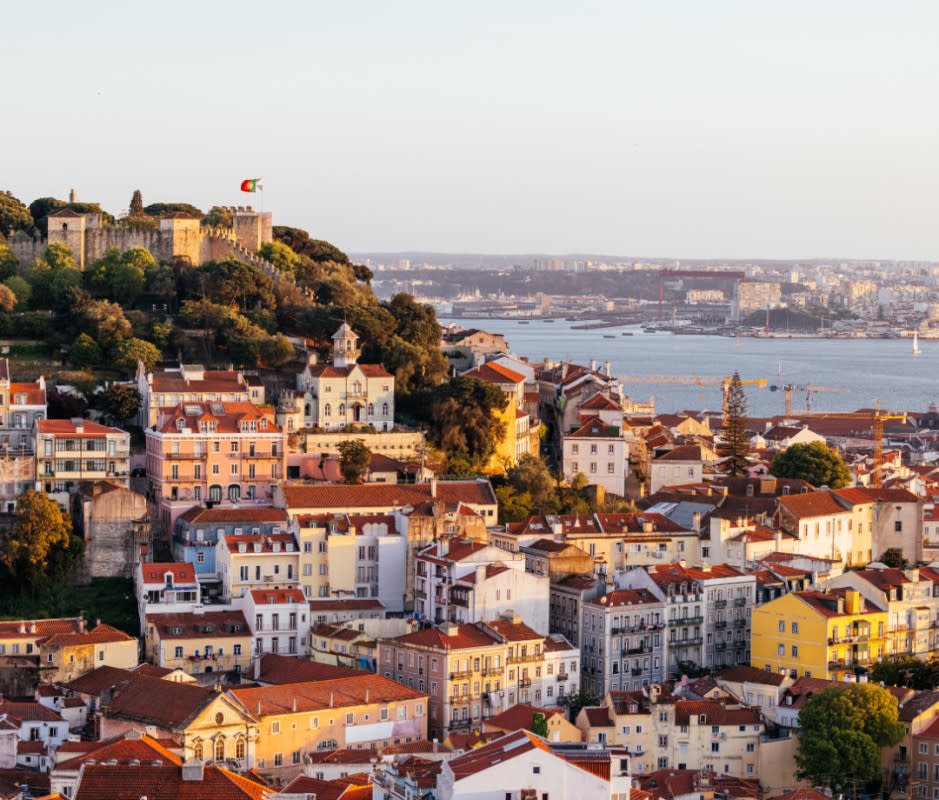
Getty Images
Its primo setting at the mouth of the Tagus River, which empties into the Atlantic, helped make Lisbon a cosmopolitan settlement from the days of Phoenician traders and North African rule. Though smartphones are ubiquitous and remote tech workers the norm, Lisbon still proudly displays its back pages. The hilly old quarter of Alfama, a warren of alley dwellings dating back to Arab roots, is a must-see, with buildings sporting the famed painted tiles that also originated in North Africa. Stop in at Parreirinha de Alfama, one of the oldest fado restaurants, whose performers have included the great diva Amalia Rodrigues herself, and catch the ultimate power vocal.

Joe Robinson
Scramble up to the castle looming over the city—the Castle of St. George—which dates to the second century and Roman days, for a spectacular view of the city and the Tagus. As an adventurous traveler, you'll want to visit the stunning Monument of the Discoveries on the Tagus, a giant, ship-shaped, stone ode to exploration that depicts Vasco da Gama, Cabral, Magellan, and other great navigators. Da Gama and Cabral sailed right by where you stand into the complete unknown. Don’t miss the Museu de Marinha, the maritime museum, nearby in the Belem district, which chronicles the Age of Discovery, from caravel models to ancient maps.
Where to Stay: Pousada Alfama
It would be hard to find a better located roost in Lisbon than the Pousada Alfama. A renovated historic edifice that blends modern and vintage décor, the hotel is perched at one of the highest points of Alfama, near one of the most prized vista points in the city, the Portas do Sol, overlooking a sea of red rooftops all the way to the Tagus River. You’re in the heart of the action, restaurants everywhere, including the outstanding Frei Papinhas on Sao Tome Street. You're also in walking distance of landmarks from the Castle of St. George to the Santa Justa elevator and the enormous central plaza, Praca do Comercio.
Best Day Trip: Sintra
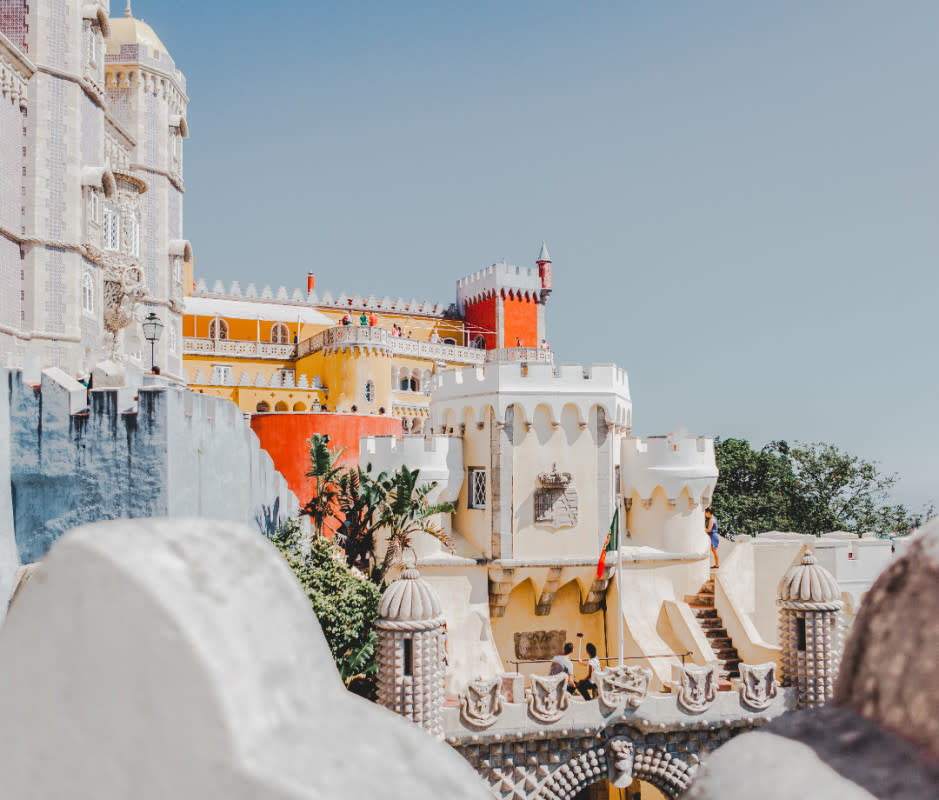
Getty Images
A 45-minute drive from Lisbon, the city of Sintra is a fabulous, forested realm that sports some of the country’s most striking architecture, which won it UNESCO World Heritage Site status. Like hill towns the world over, Sintra is cooler than the surrounding climate, a big feature in the days before AC and now. As a result, it’s been a popular residence for rulers and royalty through the centuries who left behind a slew of idiosyncratic architectural statements and estates. At the top of that list is the Pena Palace, a mashup of medieval architecture towering over the city on a hilltop surrounded by woods. Painted in pastel golds, yellows, and burgundy, the palace is a fever dream of styles, from Neo-Manueline to Neo-Islamic and Romanticism. You can tour this restored former home of King-Consort Ferdinand, the 19th-century eccentric mind behind it all, and Queen Maria, and beam into an exact replica of what home sweet palace looked like.
The Sintra area has a range of hikes to choose from. A 2.1 mile trek takes you from the Sintra National Palace downtown, home to Moorish rulers and then medieval Portuguese kings from the 15th century on, to the ruins of the Moorish Castle, just down the hill from the Pena Palace. There’s a longer very scenic trail for hiking and mountain biking in Sintra-Cascais Nature Park, Rota da Lagoa Azul, which takes you to a jewel of a lake created by a dam on the Rio da Mula.
Where to Stay: Quinta Verde Sintra
If you decide to stay overnight, try the very affordable Quinta Verde Sintra, a guesthouse just outside town with a view of castles in the hills. You get a taste of homestyle country living and travel tips from the proprietors.
Best for Adventure: Nazare

Getty Images
About 90 minutes north of Lisbon, Nazare was once a quiet fishing village and beach attraction on Portugal’s Atlantic Silver Coast. Then surfers found that it’s home to the largest waves in the world. Thanks to a huge undersea canyon and a collision of two wave directions, the boggling swells here get thrown skyward as high as 100 feet. In 2020 Sebastian Steudtner set the latest record for riding one of these monsters: 86 feet. The waves are so large surfers have to be towed by jet skis into position to catch them. It’s an incredible spectacle you can view and film from a clifftop lighthouse. If you want to feel the adrenaline of riding one of these giants, you can ride with an experienced tow driver into the fury with Atlantic Safaris. You can also rent a jet ski for yourself to explore the local coast beyond the big break you don’t want to be your neck. If you prefer land-based mountains, you can ride the hill trails no sweat on an ebike tour. Or take an ocean cruise on an e-bike ride along the beach path.
Where to Stay: Hotel Magic
You’re only a couple minutes from Nazare’s non-tsunami south beach at the Hotel Magic, a well-appointed, modern hotel with reasonable rates and an artistic flair. The rooms are sunny, spacious, and the free breakfast has everything you need to fuel up for the day’s adventures. It’s a brief walk up to the north beach, where the humongous waves crash.
Best Medieval University Town: Coimbra
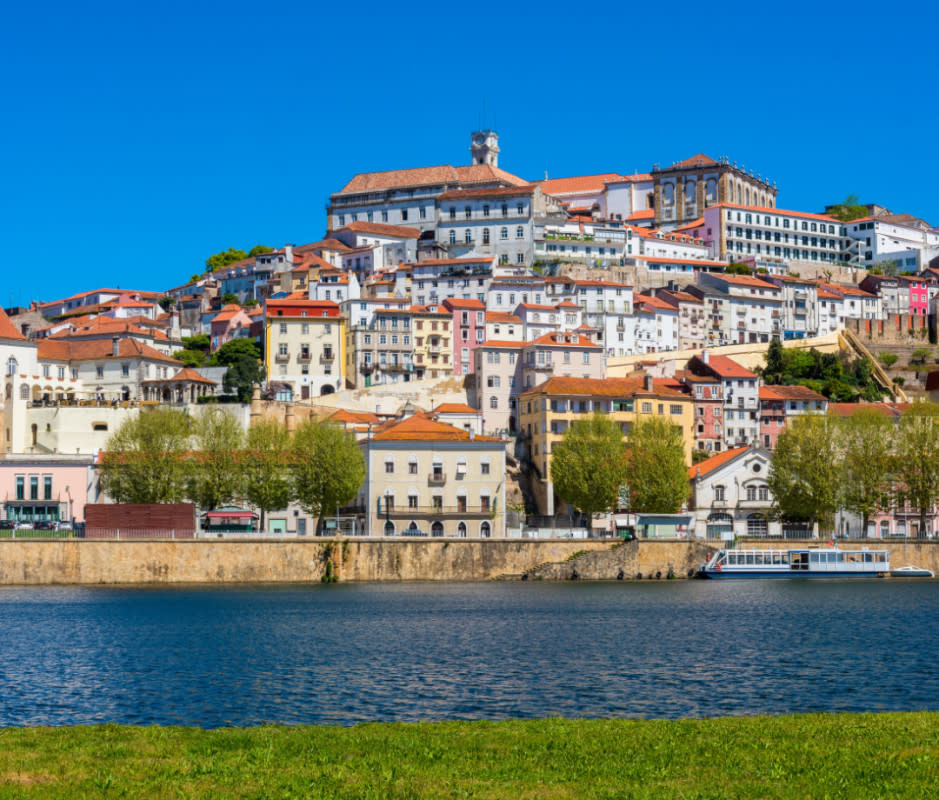
Getty Images
Back in the 13th century, Coimbra was the capital of the Kingdom of Portugal. Its deep roots as a cultural center go back as far. Home to the oldest university in the country, Coimbra is the Oxford of Portugal. It’s sometimes dubbed the “city of students.” The University of Coimbra was established in the city in 1308, after moving from Lisbon, and it’s still going strong. Take a tour of its boggling Baroque Joanina Library, which has 60,000 books from the 16th to the 18th century.

Joe Robinson
The university sits atop the picturesque old town of Coimbra, which rises from the banks of the Mondego River. Winding alleyways lead to cafes, old towers, the 13th-century cathedral, Se Velha de Coimbra, museums, and remnants of Roman and Moorish days. Coimbra is known for its traditional style of fado music, made by students from the university. Catch a fantastic fado performance at Fado ao Centro.
Where to Stay: Casa da Alegria
The best lodging deal in Coimbra may be the Casa da Alegria. You can choose between well-appointed studios and one-bedroom apartments with all the comforts of home—for $100. You get a fantastic location, with great views of the Mondego River while being in the heart of the city. It’s a brief walk to the Joanina Library, the university, the winding alleys of the old town, and a short jaunt to the impressive Botanical Gardens.
Best for Beaches: The Algarve
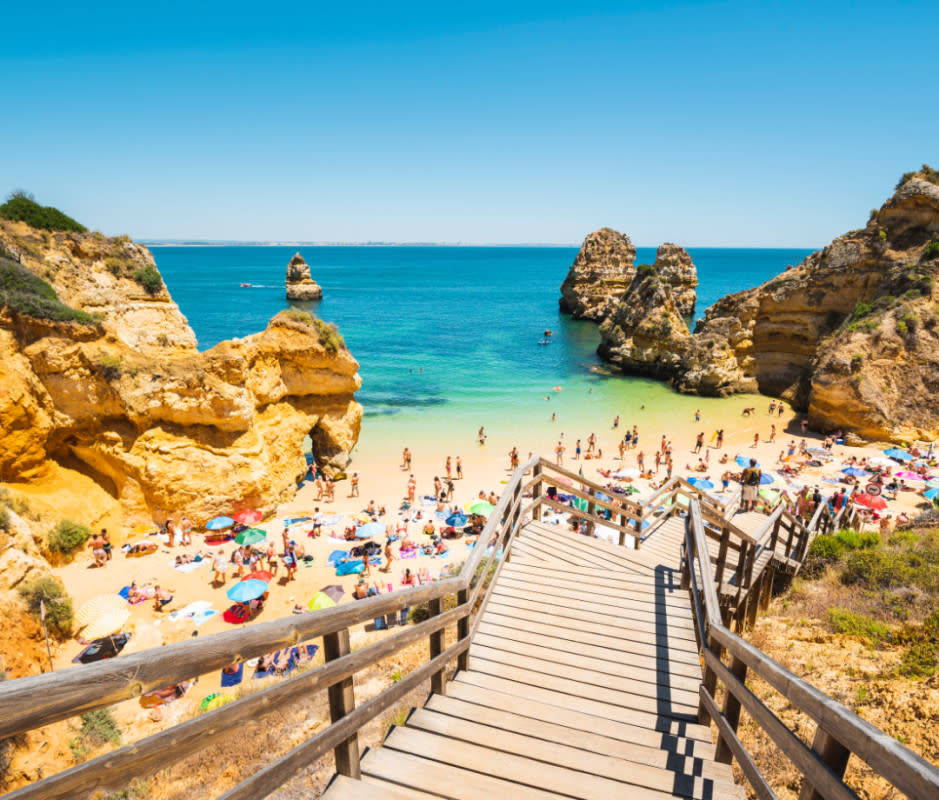
Getty Images
It’s hard to confine the beach attractions of Portugal, surrounded by ocean on two sides, to one spot. There are numerous great shores to head for. Just south of Lisbon, Praia de Figueirinho in Setubal is a serene crescent of sand at the base of green hills, and the white sand and turquoise waters of Praia de Galapos beach in Sao Simao look like something out of the South Seas. The area best known for its beaches is the Algarve, on the southern coast of the country. One beach there, in particular, has grabbed attention in recent years, Praia do Marinha, outside Carvoeiro. The Michelin Guide placed it in the top 10 most beautiful beaches in Europe. Looming up from the secluded beach are dramatic limestone cliffs and a series of karst towers and arches like something out of Cabo San Lucas. Nearby at the Benagil Caves, you can paddle surf and kayak under and around mind-blowing rock formations that are an instant highlight of any trip.
Where to Stay: Tivoli Carvoeiro Algarve Resort
The Tivoli Carvoeiro Algarve Resort, perched atop seaside cliffs 11 minutes from Marinha Beach by car, is an extraordinary base camp, a five-star hotel at three-star prices. The surroundings are spectacular, with the hotel built into the natural setting. You can take steps down the cliffs to the beach or dine on the edge of the cliffs from up above. The Benagil Caves are 17 minutes away by car.
Best Wine Hub: Porto
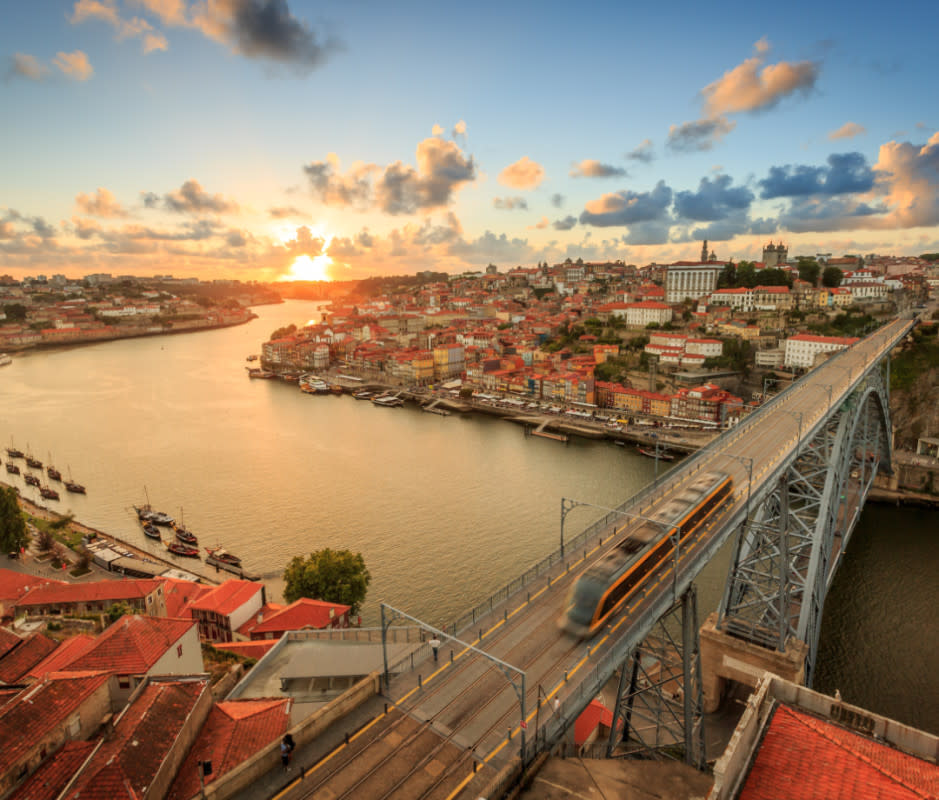
Getty Images
The northern town of Porto, Portugal’s second largest city, is a gem two miles from the Atlantic coast. Its dramatic setting along the Douro River, with steep hillsides on both sides of the river and towering bridges make it a stunning destination. The riverwalk area on the city side is bustling with cafes, restaurants, and musicians. The city has a vibrant cultural scene and nightlife options. Like Lisbon and Coimbra, it was built on a hill for defensive fortifications, so all streets and roads from the river head uphill. Take the ancient stairs to the upper level of the city, get a great workout, and find incredible views, medieval cathedrals, and a rail station covered in exquisite, massive historical paintings made of tiles.
Located next to one of the main wine regions, the Douro Valley, Porto is a hub for the nation’s famed port wine, said to have been originated by British traders in the 17th century who added grape brandy to preserve the wine on its voyage to England. Trek across the suspension bridge to Vila Nova de Gaia on the south side of the river, and you’ll have plenty of port and wine tours to choose from. Some of the best places for imbibing are Caves Ferreira and Caves Calem. For more tasting adventures, take a day trip tour of wineries in the Douro Valley.
Where to Stay: Ribeiro do Porto Hotel
Right in the thick of the riverside action, the Ribeiro do Porto Hotel is a great base for explorations. Get a room overlooking the square below and the panoramic scene of the river and bridge and spend some time savoring the spectacle and your hotel choice. You’re steps away from cruises on the river and dozens of restaurants.
Best City for Canals: Aveiro
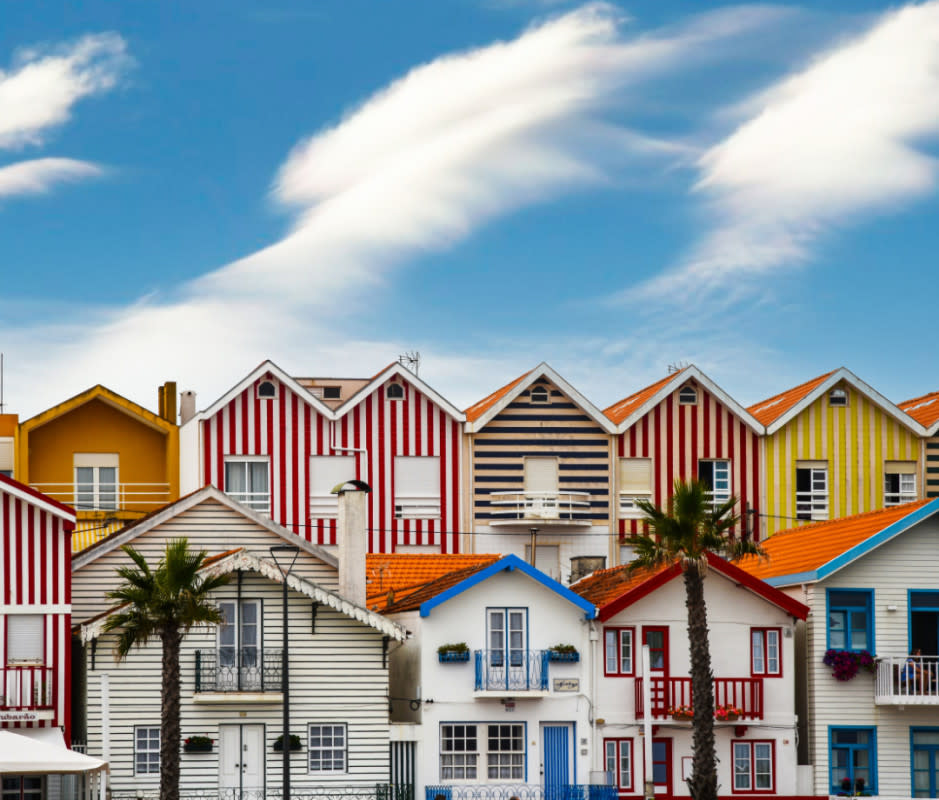
Getty Images
Known as Portugal’s Venice for its canals, Aveiro is well worth checking out. It’s just south of Porto in the north of the country and easy to get to by rail. Its quaint, old-town center is lined with well-preserved Arte Nova buildings astride the waterway. Aveiro is a great place to downshift. Take a ride in a gondola—or as they call them here, barcos moliceiros, with their fanciful, super-bowed prows—and you’ll glide under charming arched bridges and be transported back in time. To catch up on the local history, stop in at the impressive 15th-century cathedral, Sao Domingos, or the Aveiro Museum, a former convent and embroidery works that has exhibits on King Afonso V and his daughter, Joana, both buried here. If the weather’s warm, you have plenty of choices for beaches, from Costa Nova do Prado to Barra and Gafanha da Nazare.
Where to Stay: Hotel Aveiro Centro
There’s truth in advertising at the Hotel Aveiro Centro, which is, as stated in the name, very centrally located, a big selling point. It’s walking distance to most of the attractions, restaurants, and nightlife as well as the moliceiro gondolas plying the canals. This small hotel has big free breakfasts, spacious rooms, and plenty of reasons to stay here.
Best Architectural Site: Evora

Getty Images
The image most associated with Evora, a historic city about 80 miles east of Lisbon, looks like it came from Rome, and it did. The Roman Temple of Evora dates back to the 1st century and homage to Emperor Augustus. It’s located smack in the main square of the city, its remaining base and ornate columns an echo of the classic Corinthian style that came from Greece. The temple shares the city with various major centuries-old edifices, which made Evora yet another Portuguese city awarded UNESCO World Heritage status.
The Cathedral of Evora is one of the top gothic structures in the country, built in the 13th century. The Igreja de Sao Francisco has Manueline stylings, plus Baroque chapels. One of those chapels, the Chapel of Bones, is quirky, to say the least. Its walls are decorated with human skulls and bones meant to remind folks of their mortality. It accomplishes that mission. There’s a sign in the chapel that says in the category of eternal humor, “We the bones here are just waiting for the arrival of yours.” After that, it may be time for some fresh air. You can rent a bike or hike to tour the nearby countryside, making your way past orchards of olive trees and cork. Check out Portugal’s Stonehenge on the outskirts of the city. Some of the dolmen, or arranged rocks, are 2000 years older than Stonehenge. The Almendres Cromlech has some 100 megalithic stones, which, like Stonehenge, are thought to be connected to tracking the movement of the sun and moon.
Where to Stay: M'ar de Ar Aqueduto
A former monastery that has been turned into an elegant, modern hotel, the M’ar de Ar Aqueduto is a smart choice for your stay in Evora. As its name implies, the hotel is right next to a Roman high-rise aqueduct, which makes a wondrous and time-fracturing backdrop from poolside and your room with quite a view. The hotel is centrally located near all the main attractions.
Best for Hiking and Wilderness: Parque Natural da Serra Estrela

Getty Images
Located in the eastern mountains of Portugal in the upper third of the nation, the Parque Natural da Serra Estrela is home to the country’s biggest mountain range (highest peak: 6,561 ft) and protected parkland. In the sparsely habited areas at the base of the mountains, you'll find life still moves to a traditional beat. Shepherds tend sheep and goats. Wooly coats and cheese emerge as they have for centuries. The park has dozens of hiking trails with spectacular views. The Route of the Six Lakes takes you on a 5.5-mile swing around six lakes. The Serra Estrela is the source of the Mondego River and through a tributary, the Tagus River, so it’s the major watershed of the nation. The Circular Route of Manteigas via the Carvao Trail is a beautiful 13.8-mile-long circuit beginning and ending at the village of Manteigas. You can take in the natural neighborhood around the village of Unhais da Serra and meet some locals along the way on the Unhais da Serra to Barragem da Estrela trail, a moderate 3.3 miles in length.
Where to Stay: Casa Lagar da Alagoa
After hiking or biking adventures, you'll need a cozy home, hot shower, and a comfortable night’s sleep. The rustic Casa Lagar da Alagoa, outside the park, is an ideal solution. With seven double rooms and two suites, you will feel like you are home on the Portuguese range, with great hospitality from the friendly proprietors.
Best Southern Coast Base: Lagos
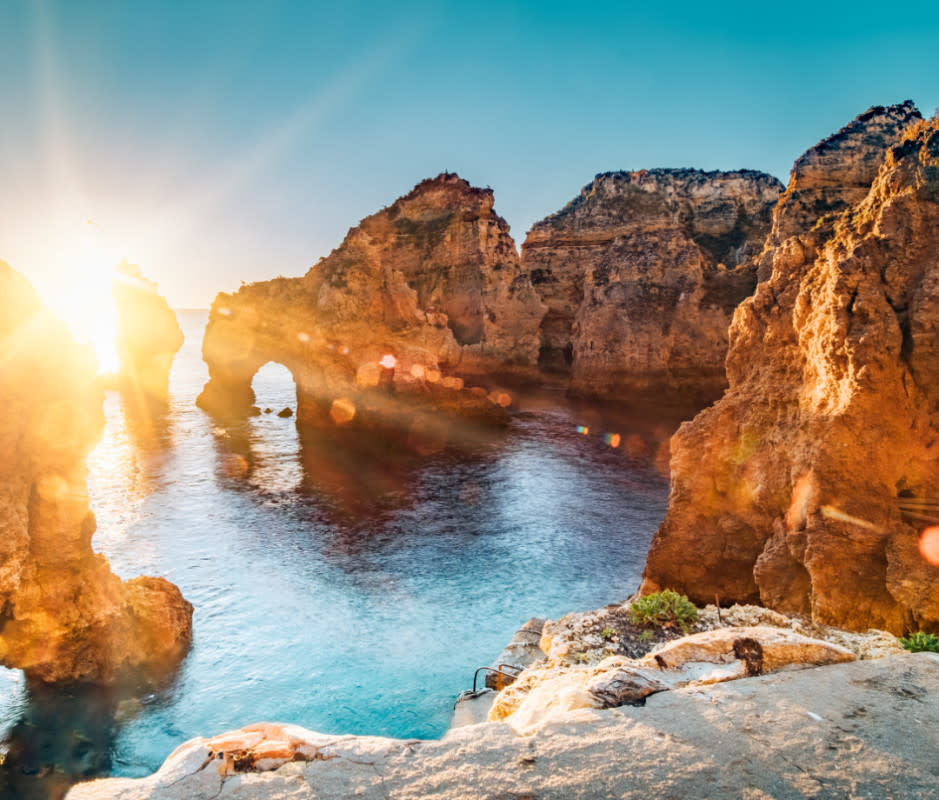
Getty Images
The ancient maritime port of Lagos is a gateway for tourists from the north of Europe looking for sun and fun. It’s had many occupiers and rulers through the years, from Carthaginians to Romans, Visigoths, Moors, and for many decades now flip-flops and beach towels. Lagos was the embarkation point for many a voyage in the Age of Discovery and a home to Portugal’s chief financial backer of those missions, Henry the Navigator. The Lagos area has some of the Algarve’s best beaches, such as Dona Ana, one of the country’s biggest stretches of sand, as well as fantastical limestone cliffs and island towers—namely, the amazing Ponta da Piedade, well worth a hike from above the formations, as well as kayaking around the caves, grottoes, and rock-sealed lagoons below. The old town is lined with classic Portuguese architecture and colorful edifices. You’ll find plenty of entertainment, bars, and shopping available here too. For a dose of artistry, check what’s on at Centro Cultural de Lagos, which offers musical performances and exhibits from archeology to the visual arts.
Where to Stay: Dom Manuel Hotel
The Dom Manuel Hotel is a refreshing change of pace from the large chains. It’s a one-of-a-kind garden residence hotel—just two floors—with spacious verandas for each pool-facing room and reasonable rates. There are nice touches of Portuguese tile artistry, princely furniture, and modern flourishes as well. It’s less than a 10-minute walk to downtown and a few minutes longer to the beach.
When to Visit Portugal
The clear time not to go to Portugal is summer, and especially August, when heat, crowds, and high-season rates will sap your travel spirit and wallet. That goes in a big way for the southern beach cities on the Algarve, Lisbon, and Porto—the northern city that can seem to be the most popular site in Europe that month. You’ll find more hotels, cafés, train seats, trails, and vista points available (and all at cheaper prices) by visiting Portugal in the off-season, February to March or October to November.
Flights to Portugal
Tap Air Portugal has nonstop flights to the capital city of Lisbon from six U.S. cities: Washington, D.C., New York, Newark, Miami, Boston, and San Francisco, and you can also get there direct on Delta from JFK New York and United Airlines from Newark. Yet many other airlines fly to Lisbon with one stop at decent prices. Round-trip fares ranged from $622 to $650 on Expedia for a March trip from Los Angeles to Lisbon on Air Canada, KLM, American, Iberia, and British Airways. The best deals are in the winter and early March to April. Fares to Portugal increase 46% in June, reports kayak.com
Why You Should Trust Me
With multiple Portugal sojourns under my belt, a host of fado albums in my collection, caravel tiles on my wall, and a passing fluency in Portuguese, I have followed the culture of this formerly under-the-radar part of Europe intently for a long time. Its heyday in the Age of Discovery might be long gone, but it’s still leading the way in quality-of-life metrics, health care, and digital nomads.

